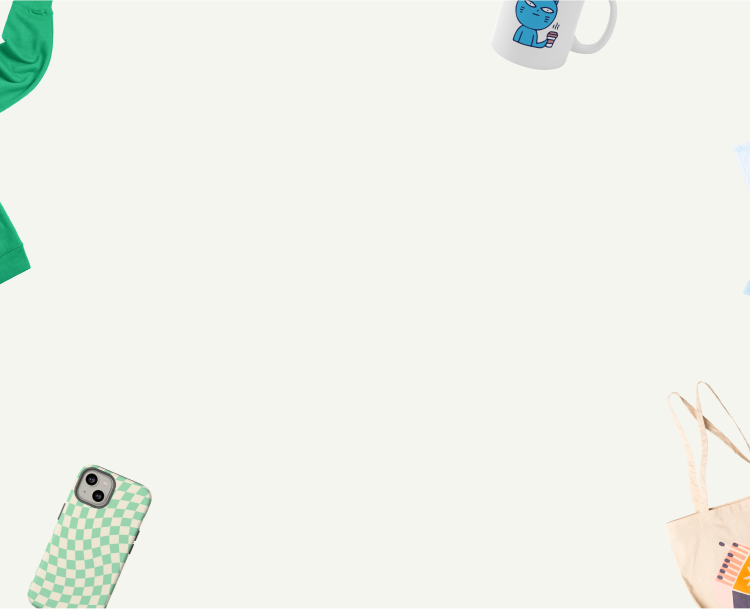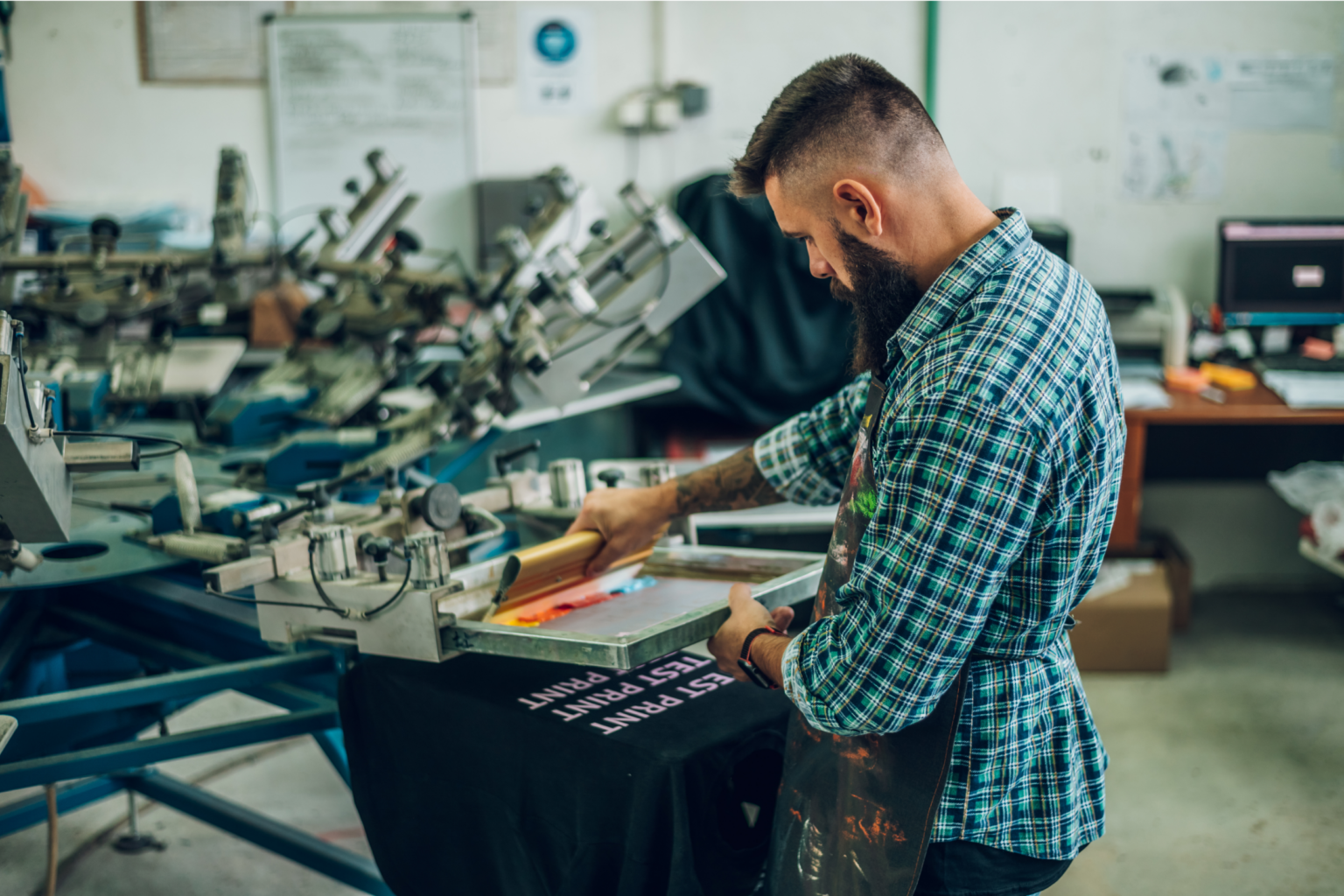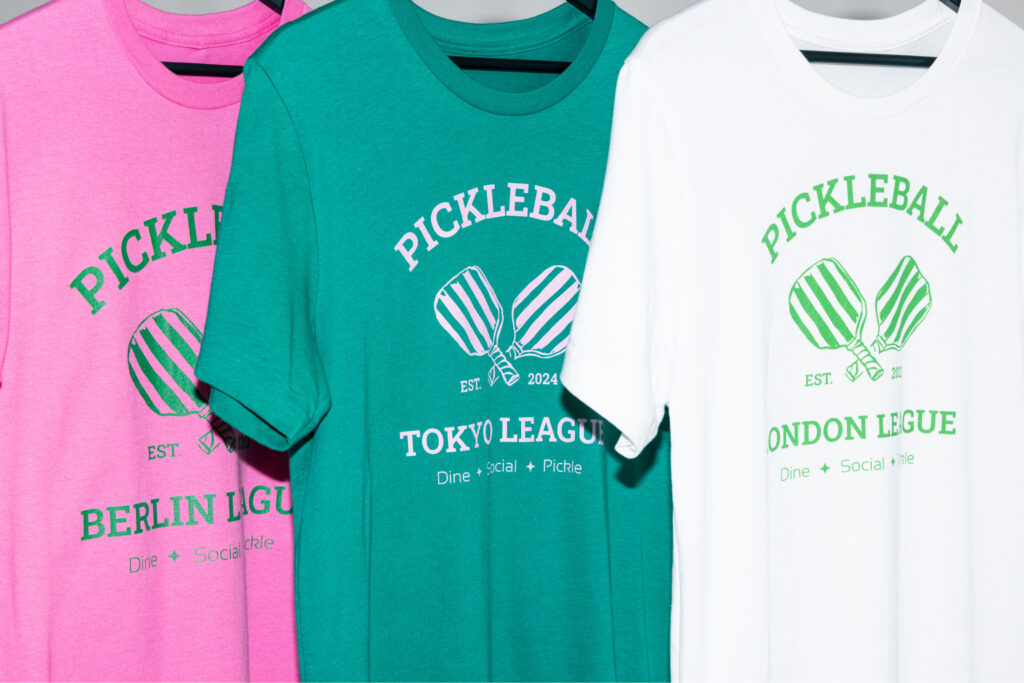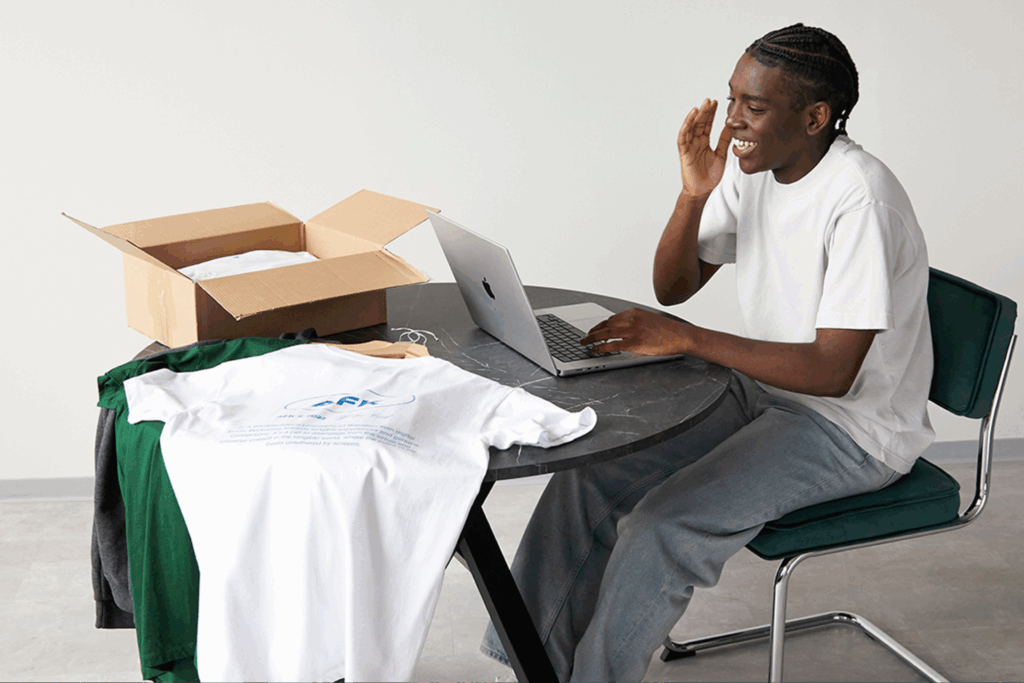Start your custom printing business today!
A print-on-demand t-shirt business is one of the simplest ways to earn real money online. T-shirts sell year-round, and with the right setup, you can start an online t-shirt business with zero upfront costs.
This guide explains how to start a print-on-demand t-shirt business, from market research and choosing an eCommerce platform to creating t-shirt designs so you can start selling quickly.
This post may contain affiliate links, which means we may earn a commission if you make a purchase through those links. This comes at no additional cost to you.
Key takeaways
- The custom t-shirt market is expected to grow by 11.27% annually from 2025 to 2034, making now a great time to launch your POD business.
- Partnering with a print-on-demand service like Printify reduces upfront costs, streamlines operations, and lets you focus on creating and marketing your t-shirts.
- Choosing a specific niche, like dog lovers or pickleball enthusiasts, helps you stand out and target a defined audience.
- Effective marketing and business strategies, including social media marketing, influencer partnerships, and SEO, are essential to driving traffic and increasing sales.
- Tracking sales data and customer feedback helps you refine your t-shirt designs and pricing to build a successful t-shirt business.

“Keep going and never give up. One day, you’ll look back at the numbers and realize people have spent $30,000 in your shop. The whole concept is amazing, though I still find it hard to believe sometimes.”
Why are print-on-demand t-shirts still a winning business idea in 2026?
The global custom t-shirt printing market is valued at more than $7 billion in 2025 and is projected to grow 11.27% annually through 2034.
Strong, steady demand makes a t-shirt business a great opportunity, especially when you use the print-on-demand model to skip inventory, reduce risk, and launch faster.
When you’re learning how to start a print-on-demand t-shirt business, the first step is choosing which type of t-shirt operation you want to build. Here are the two main options.
Retail vs eCommerce business
Global online sales are forecasted to reach $6.4 trillion by 2026 and exceed $8 trillion in three years.
That growth shows that selling through your own t-shirt business online is far more flexible and scalable than relying on a physical storefront.
Let’s break down the key differences between retail stores and eCommerce options.
| Traditional retail | eCommerce | |
| Location | Brick-and-mortar shop.You need a physical location to store and sell goods. | eCommerce Website.No need to store goods if you use dropshipping or Print on Demand. |
| Accessibility | Limited to location and specific working hours. | Sell 24/7. |
| User experience (UX) | Customers have immediate access to products and support staff.Finding products takes time. | Access to products via photos, descriptions, reviews, and online support.Finding the right product is easier with search functions. |
| Delivery | Customers get their purchases immediately. | Products need to be shipped, which takes time and shipping costs. |
| Business costs | Rent, utilities (warehousing, physical store), inventory, and staff. | Depends on your chosen eCommerce platform.Print on Demand with Printify is free. |
| Setup difficulty | Months of preparation and a significant upfront investment. | An online t-shirt store can be up and running in minutes with no upfront costs. |
Learn more about business models like Print on Demand and how to start a print-on-demand business.
How to start a t-shirt business: A complete guide
Let’s start your clothing line, one step at a time.
1. Validate your t-shirt niche

Before you launch your print-on-demand business, validate the niche you plan to build your t-shirt business around. Strong market research reveals what customers want, which categories are saturated, and where your online t-shirt business can stand out.
Review what already sells
Search marketplaces like Amazon and Etsy for:
- Trending t-shirts
- Best-selling tees
- Popular t-shirts
Then refine those searches with niche terms tied to your target audience (e.g., tennis player t-shirts, Italian Greyhound t-shirts). This helps you spot early demand for your t-shirt business.
Analyze real competitors
Review a successful t-shirt brand or Shopify t-shirt store for inspiration:
- What designs sell best?
- How do they price their products?
- What do customers praise or complain about in reviews?
This reveals gaps you can fill and helps you position your t-shirt business online with stronger t-shirt designs.
Validate with data
Use tools like Google Keyword Planner and Google Trends to understand:
- Search volume and related queries
- Customer intent
- Long-term interest in your niche
These insights clarify your target market, what they search for when buying t-shirts, and where your niche fits within the broader print-on-demand market.
Narrow your niche
Choose a focused, profitable group.
Instead of “women with pets,” refine to “women in California who own Labrador Retrievers.” A tight niche makes it easier to design products people want, improve your marketing efforts, and build an online store that attracts real buyers.
For more print-on-demand niche examples and validation strategies, explore our guides on the Printify blog and YouTube channel.
Learn how to sell t-shirts on Amazon and Etsy.
2. Write a business plan

A business plan outlines your:
- Goals
- Timeline
- Chosen business model (like using a print-on-demand partner)
Business plans for traditional retail models are usually detailed and cover the business idea, target market, structure, and product, and they’re often required for loans or financing.
Many small business owners using POD to print shirts prefer a lean plan, which highlights key activities, revenue streams, assets, partners, and a clear, unique selling proposition.
The US Small Business Administration website offers templates for both formats.
3. Choose the right POD platform
Wondering how to start a t-shirt business online without worrying about inventory management, fulfillment, and initial investment? Work with print-on-demand companies.
Once you sell a t-shirt online, a POD company will print, package, and ship it to your customer. This leaves you with plenty of time to focus on creating new designs and marketing your t-shirts.
Printify and Printful are the best choices for starting your t-shirt company.
Here are Printify’s main benefits:
- No upfront production cost: Create an account and start selling t-shirts online for free.
- Largest selection in POD: Get instant access to our Catalog of over 1,300 items, including high-quality t-shirts from popular brands.
- Worldwide shipping: Our international network of Print Providers will ship your orders around the globe.
- 24/7 support: Our team is always here to help you with any questions.
- Design tools: The free Product Creator has tons of valuable design tools, like a pattern creator, a text editor, an AI Image Generator, and a graphics library with free t-shirt designs.
- Integrations: We offer integrations with all the popular eCommerce channels to streamline listing and order management.
4. Pick a t-shirt
Not all blank t-shirts are equal – they come in a range of fabrics, styles, and fits. You need to choose the t-shirt models that your customers will love most.
Here’s a quick t-shirt 101:
- T-shirts are made from various fabrics. The most popular ones among consumers are cotton, polyester, or blends.
- Some fabrics and designs are more compatible with specific printing techniques. For example, direct-to-garment printing (DTG) looks best on 100% cotton or polyester-cotton blend shirts. In contrast, all-over print (AOP) shirts only work on polyester and other synthetic fabrics.
- Eco-friendly options made from organic and sustainable materials will be a hit with environmentally conscious shoppers.
Always order product samples to ensure the t-shirt design and fabric quality match your expectations.
How to choose a t-shirt from Printify:
- Browse our Catalog for women’s, men’s, and kids’ t-shirts to find one your target audience will love.
- Choose from over 20 high-quality brands, including Bella+Canvas and Gildan.
- Choose a Print Provider, considering their score, location, and production time.
Watch this comparison video between the Bella+Canvas 3001, Gildan 64000, and Gildan 5000, and check out our article on the best t-shirts for printing.
5. Design your t-shirts like a pro

A good design is the key factor influencing customers to buy from your online t-shirt business.
- Conceptualize: Brainstorm t-shirt design ideas that resonate with your target audience and brand identity.
- Find your design style: Explore online resources and tools to create your own t-shirts, or consider collaborating with freelance artists on platforms like Fiverr or Upwork.
- Prioritize quality and simplicity: Keep your t-shirt designs clean and professional, using high-quality visuals and easy-to-read fonts.
How to apply your t-shirt design using Printify:
- Use our Product Creator to upload and adjust your design placement on the t-shirt. Use features like the AI Image Generator to create something entirely new without hiring professional designers.
- Generate product mockups to visualize your designs.
- Order samples to ensure quality before adding products to your store.
Find more graphic design tips for creating a best-selling t-shirt design.
6. Create an online store
Once you’ve made some custom t-shirts, you’ll need a place to sell them.
The easiest and fastest way is to create a marketplace storefront or an eCommerce store. Printify easily connects with the most popular platforms – simply pick the one best suited for your online t-shirt business.
Marketplaces (Etsy, eBay, Amazon):
| Pros | Cons |
|---|---|
| Lower to no initial cost Loyal existing customer base | Fewer customization options Lack of branding control Marketplace policies Fees |
eCommerce platforms (Shopify, BigCommerce):
| Pros | Cons |
|---|---|
| Comprehensive eCommerce features Vast customization options Full control over your own website | Ongoing expenses for subscriptions and fees No built-in audience Requires lots of work to market and drive traffic |
All-in-one website builders (Wix, Squarespace)
| Pros | Cons |
|---|---|
| Beginner-friendly editors Blogging capabilities Good search engine optimization (SEO) options | Subscription and app fees No pre-existing traffic |
Printify API, open-source platforms, CMS, and plugins (WordPress and WooCommerce, PrestaShop)
| Pros | Cons |
|---|---|
| Full customization and control Relatively low annual costs (hosting, domain name, and plugins) compared to other platforms | Technical skills required Steep learning curve |
| Pros | Cons |
|---|---|
| Free and easy to set up Launch your store in minutes No need for developer assistance | Fewer customization options |
Check out the best sites to sell online and decide which one is right for you. You can always start with one and expand to multiple platforms as your store grows.
7. Price your t-shirts for profit
When you sell t-shirts online, pricing can make or break your online business.
First, consider your variable costs, fixed costs, and competitor pricing. Then, pick the best pricing strategy for your business.
Cost breakdown
Before setting your price, analyze all of your costs.
Variable costs:
- Blank shirts: Printify partners with several Print Providers to offer a variety of t-shirt styles and materials at different price points. Choose based on your target audience and design needs.
- Printing: Cost varies depending on the printing technique (e.g., DTG, screen printing).
- Shipping: Factor in both domestic and international shipping rates based on your target market.
Fixed costs:
- Online store platform fees: Many platforms offer free trials or tiered plans. Don’t forget about transaction fees.
- Marketing and advertising costs: Budget for social media ads or influencer marketing if needed.
- Design software subscription (optional): Look for free design tools or low-cost subscription plans.
Competitive research
Take a look at how competitors price their products in your t-shirt niche. Monitor how often they have sales and what their average prices are – and look for ways to get the upper hand.
Pricing slightly below your competition can attract new customers while maintaining healthy profit margins. If your designs or materials are of higher quality, consider a premium pricing strategy and market the added value.
Popular pricing strategies
Explore these popular pricing strategies to find the best fit for you:
- Cost-plus pricing: A straightforward approach in which you add a desired profit margin to your total costs (variable + fixed) to determine your selling price.
- Keystone pricing: This business strategy involves doubling your wholesale cost (t-shirt + printing) to set your retail price. While simple, it might not always align with market competition.
- Value-based pricing: Set your price based on the perceived value your t-shirt offers the customer, considering factors like design, brand identity, and material quality.
- Competitive pricing: Analyze competitor pricing and adjust yours slightly higher or lower based on your value proposition.
Check out our t-shirt pricing calculator to simplify the process.
8. Promote your products
Creating designs and setting up your store is just the beginning. To make sales, you’ll need effective marketing strategies. Take a look at these tips to reach potential customers.
- Utilize social media platforms: Use Instagram, TikTok, and Facebook. Focus on where your niche audience spends most of their time online.
- Leverage influencer marketing: Partner with influencers in your niche. They can help you reach a larger audience and build credibility.
- Search engine optimization (SEO): Learn about SEO to improve your online t-shirt store’s visibility. Use relevant keywords in product descriptions and consider starting a blog to drive more traffic to your store.
- Paid advertising: If your budget allows it, invest in paid ads to increase your visibility and attract more customers.
- Creative marketing campaigns: Plan creative marketing campaigns to catch your target audience’s attention. Think outside the box to make your t-shirt brand stand out.
Focus on these strategies to effectively market your t-shirt business and increase sales.
Explore our articles on WooCommerce SEO, Shopify SEO, Wix SEO, and Etsy SEO.
9. Scale your POD t-shirt business
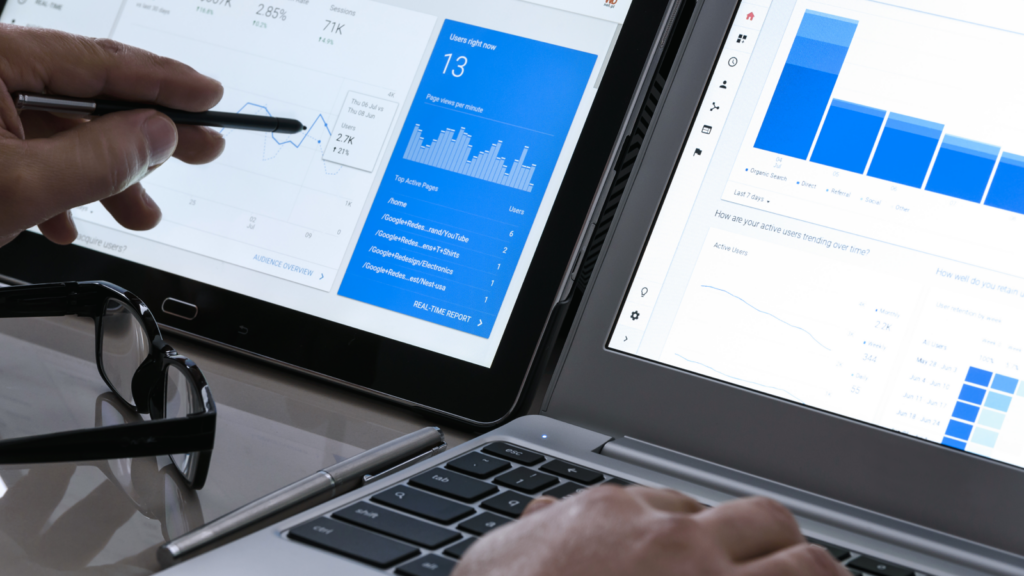
Once your t-shirt business is running, focus on scaling – increasing revenue, expanding your product line, and improving how you attract potential customers. Growing a print-on-demand business doesn’t require inventory, but it does require data-driven decisions.
Analyze performance
Use your eCommerce platform analytics to see:
- Your best-selling t-shirt designs
- How customers interact with your online store
- Traffic sources and conversion data
If you use Google Analytics, track demographics and repeat behavior to build a loyal customer base.
Expand your product line
Add new t-shirts, variations, and complementary items like hoodies and accessories. Bundling products boosts average order value and helps you scale a t-shirt business online.
Keep designs fresh
Experiment with new artwork, seasonal drops, and limited-edition t-shirt designs to stay visible year-round across sales channels.
Use automation
Connect tools to your print-on-demand services to streamline order routing, multi-channel selling, and fulfillment. Automate email flows, abandoned cart reminders, and retargeting to bring shoppers back.
Automation frees you up to focus on branding, design, and long-term growth – the work that moves your print-on-demand business forward.
10. Focus on your customers and follow trends
Strong customer service and trend awareness are key to growing a t-shirt business and staying ahead in the print-on-demand business.
Provide standout service
- Keep communication clear, fast, and easy to access.
- Be upfront about shipping costs, delivery, and returns.
- Resolve issues quickly to boost customer satisfaction and earn reviews that build trust with new potential customers.
Stay ahead of trends
Design demand shifts quickly – seasonal themes, cultural moments, and typography trends all influence what sells.
Use Printify Trends to spot rising styles, discover new niches, and plan timely drops that keep your t-shirt designs relevant.
Good service and trend-driven products help your t-shirt business stay competitive and continue growing.
Get inspired
Every merchant knows that starting a t-shirt business can sometimes feel overwhelming.
We spoke with three successful business owners who share their stories and offer advice to newcomers, so they can take the most straightforward path to profits.
Rich Khun
Running a successful online t-shirt business comes naturally to online entrepreneur Rich Khun. From making over $500,000 annually to being a successful YouTuber, Rich is a true inspiration for business owners.
We’re not only fans of Rich as a Printify merchant but also hooked on his YouTube channel, Hustle Ninjas, where he shares valuable advice and experience on selling t-shirts online.
Read Rich Khun’s full story.
Cassiy Johnson
Anyone exploring how to start a t-shirt company can learn a lot from Cassiy Johnson. She lost her job during the pandemic and dove into the world of print-on-demand services, soon discovering that POD was way more fun than her 9-to-5 job.
Instead of focusing on a specific niche, Cassiy has an Etsy store with products across various niches. She also teaches how to start a t-shirt business from home and much more on her YouTube channel.
Investing in custom mockups, Cassiy makes the most of holiday sales to expand her business and sell t-shirts and other apparel. She uses Pinterest and Etsy ads for marketing, but most of her sales come from organic searches.
Read Cassiy Johnson’s full story.
Lindsey Ferris
Lindsey lost her 12-year corporate event production business, but that didn’t stop her from becoming a successful eCommerce entrepreneur.
Lindsey runs an Etsy shop with over 9,500 sales of t-shirts, print-on-demand notebooks, custom mugs, and other POD products. This business model is great for anyone wanting to start their own t-shirt printing business.
Her merchandise features inspiring and empowering messages alongside calming and fun designs, making her a standout in the market.
Read Lindsey Ferris’s full story.
FAQ
With the print-on-demand model, you don’t need equipment or inventory upfront – you only pay for each product after a customer orders it.
Most sellers can start a t-shirt printing business for under $100, with costs going to an online store subscription (if you choose a paid eCommerce platform) and optional design or marketing tools.
Learn more about how Printify works.
You don’t need an LLC to start a print-on-demand business, but forming one can provide tax and liability benefits as you grow.
Many beginners start as sole proprietors and switch to an LLC once revenue increases or when they want added protection. Check local regulations or consult a tax professional if you’re unsure.
Yes. POD is one of the most cost-efficient ways to sell custom t-shirts because it removes major barriers – inventory, equipment, and upfront investment. It lets you test niches and designs with minimal risk, making it a popular path to a profitable t-shirt business online.
To start an online t-shirt business at zero cost, use a free eCommerce platform or marketplace, create designs with free tools, and connect your store to a POD provider. For example, sign up to Printify for free and open a Pop-Up Store to start selling immediately.
Since Print on Demand lets customers’ orders pay for products after purchase, you can launch without buying inventory.
Focus on simple t-shirt designs, optimized listings, and organic promotion through social media and communities to keep expenses at a minimum.
Using the print-on-demand model is the most profitable for most sellers. It eliminates inventory risk, keeps costs low, and lets you set your own profit margins. Pair it with a clear niche, strong designs, and an optimized online store for the best long-term results.
Yes. It’s a profitable business model with real earning potential. Many small business owners earn a steady income selling custom t-shirts through POD platforms like Printify.
Success comes from choosing a focused niche, creating high-quality designs, understanding your target market, and using the right marketing channels.
Designs that appeal to a specific audience perform best – minimalist typography, humor, retro graphics, or hobby and pet themes. Checking marketplaces like Etsy and Printify Trends helps you spot what customers are actively searching for.
With print-on-demand services, you can launch an online t-shirt business in a single day. The most time you’ll spend is on validating your niche and creating strong designs.
Once your store is connected to a POD provider like Printify, you can publish products and start selling t-shirts online immediately, without inventory or equipment.
Final thoughts: Sell custom t-shirts today
A print-on-demand business is one of the easiest ways to earn real income online by selling t-shirts.
With Printify, you avoid inventory costs and focus on what drives profit – strong designs, a clear niche, and marketing that brings in steady sales. As you grow, our global network of fulfillment facilities and tools help you scale your print-on-demand catalog confidently.
Start your custom t-shirt printing business today, and let us handle the rest.
